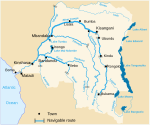geo.wikisort.org - River
The Lualaba River flows entirely within the eastern Democratic Republic of the Congo. It provides the greatest streamflow to the Congo River, while the source of the Congo is recognized as the Chambeshi. The Lualaba is 1,800 kilometres (1,100 mi) long. Its headwaters are in the country's far southeastern corner near Musofi and Lubumbashi in Katanga Province, next to the Zambian Copperbelt.

Course
The source of the Lualaba River is on the Katanga plateau, at an elevation of 1,400 metres (4,600 ft) above sea level. The river flows northward to end near Kisangani, where the name Congo River officially begins. From the Katanga plateau it drops, with waterfalls and rapids marking the descent, to the Manika plateau. As it descends through the upper Upemba Depression (Kamalondo Trough), 457 metres (1,499 ft) in 72 kilometres (45 mi). Near Nzilo Falls it is dammed for hydroelectric power at the Nzilo Dam.
At Bukama in Haut-Lomami District the river becomes navigable for about 640 kilometres (400 mi) through a series of marshy lakes in the lower Upemba Depression, including Lake Upemba and Lake Kisale. Ankoro lies on the west bank of the Lualaba River, opposite its confluence with the Luvua River from the east. Some geographers call the combined river below this point the "Upper Congo".[1]
Below Kongolo, the river becomes unnavigable as it enters the narrow gorge of Portes d'Enfer (Gates of Hell). Between Kasongo and Kibombo, the river is navigable for about 100 kilometres (62 mi), before rapids make it unnavigable again between Kibombo and Kindu (Port-Empain). From Kindu up to the Boyoma Falls at Ubundu, the stream is navigable again for more than 300 kilometres. The Boyoma Falls or Stanley Falls are made up of seven cataracts, over a stretch of 100 kilometres (62 mi) of the river, between Ubundu and Kisangani. The river's end is marked after the seventh cataract, near Kisangani, where it becomes the Congo River.
The Lualaba River serves as the northern and western boundary of Upemba National Park, protecting habitats on the Kibara Plateau in Katanga Province of the southeastern Democratic Republic of the Congo.
Tributaries
The largest tributaries of the Lualaba River are:
- Ulindi River
- Luama River
- Lukuga River — drains Lake Tanganyika.
- Lufira River
- Lubudi River
- Luvua River
- Elila River
Cities and towns

Cities and towns along and near the Lualaba River include:
- Ankoro —on west bank, opposite confluence with Luvua River.
- Bukama
- Kabalo
- Kasongo
- Kongolo
- Kisangani — near the seventh cataract of Boyoma Falls.
- Ubundu — just above first cataract of Boyoma Falls.
History
The Lualaba River was once considered a possible source of the Nile, until Henry Morton Stanley journeyed down it and proved that it drained into the Atlantic Ocean.[2] Stanley referred to it as the Livingstone. "Had not Livingstone spoken of the river at Nyangwe as the Lualaba, I should not have mentioned the word except as a corruption by the Waguha of the Wenya term Lu-al-ow-wa..."[2]: 114, 135
French colonial governor Pierre Savorgnan de Brazza also explored the Lualaba.
Notes
- Day, Trevor; Garratt, Richard (2006). "Congo (Zaire) River". Lakes and rivers. Infobase Publishing. ISBN 0-8160-5328-6.
- Stanley, H.M., 1899, Through the Dark Continent, London: G. Newnes, Vol. One ISBN 0486256677, Vol. Two ISBN 0486256685
References
- Maria Petringa, Brazza, A Life for Africa. Bloomington, IN: AuthorHouse, 2006. ISBN 978-1-4259-1198-0
External links
На других языках
[de] Lualaba (Fluss)
Der afrikanische Fluss Lualaba, auch Luala, wird als eigentlicher Quellfluss des Kongos angesehen.- [en] Lualaba River
[es] Lualaba (río)
El río Lualaba fluye en su totalidad en el este de la República Democrática del Congo. Es la mayor fuente fluvial (cabecera) del río Congo por volumen de agua. El Lualaba tiene una longitud de 1.800 kilómetros. Su cabecera se encuentra en el extremo sureste del país, cerca de Musofi y Lubumbashi, en la provincia de Katanga, junto a Zambia. El río Chambeshi es la fuente fluvial más larga (cabecera) del Congo.[it] Lualaba
Il Lualaba è il corso iniziale del fiume Congo, che va dalle prossimità di Lubumbashi fino a Kisangani, dove, dopo le cascate Boyoma, inizia ufficialmente il Congo.Другой контент может иметь иную лицензию. Перед использованием материалов сайта WikiSort.org внимательно изучите правила лицензирования конкретных элементов наполнения сайта.
WikiSort.org - проект по пересортировке и дополнению контента Википедии
